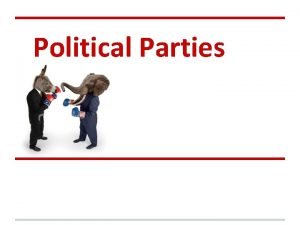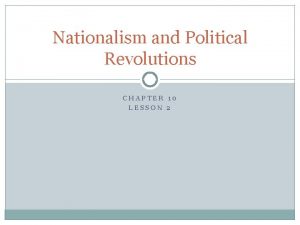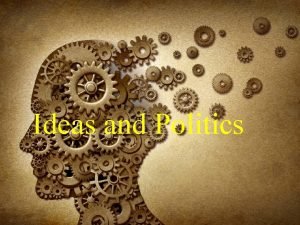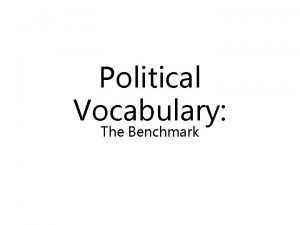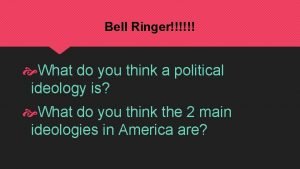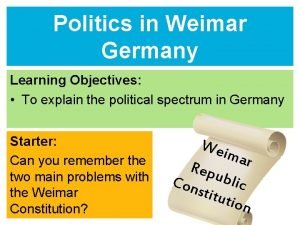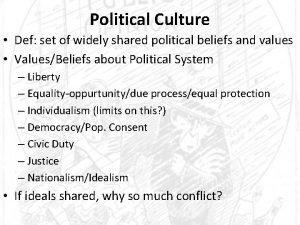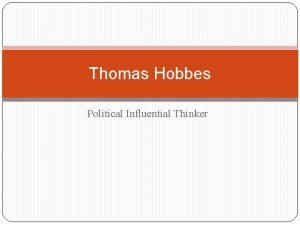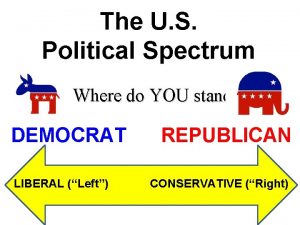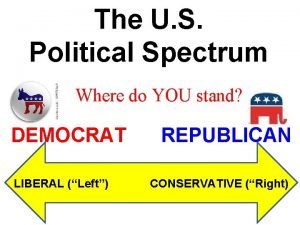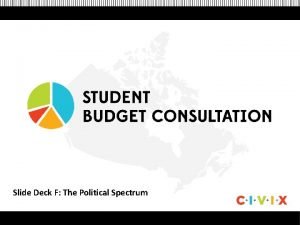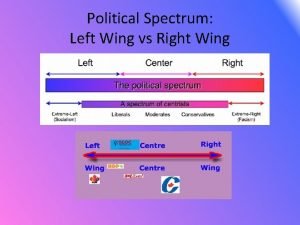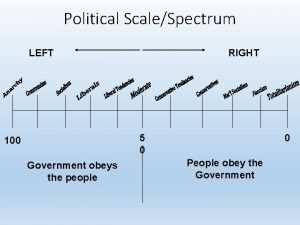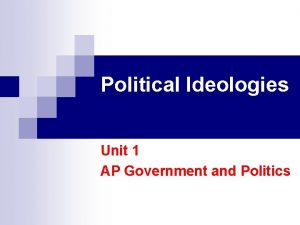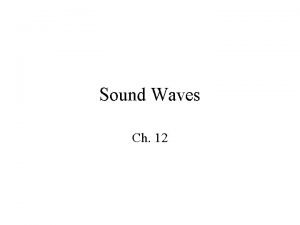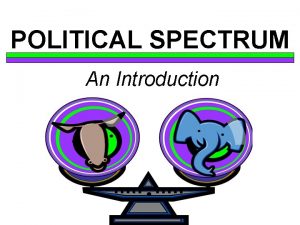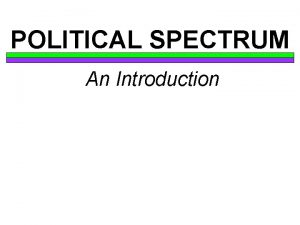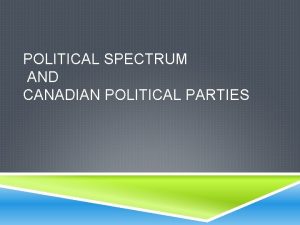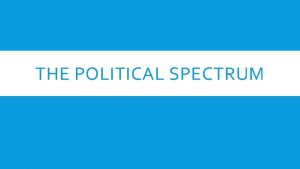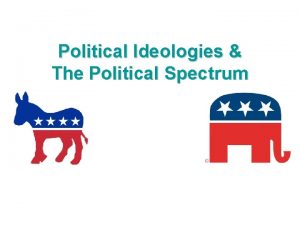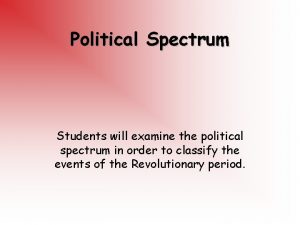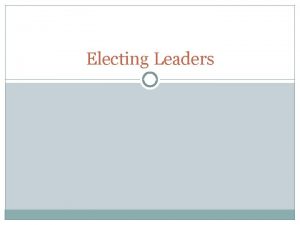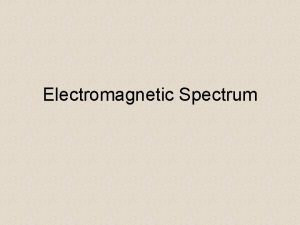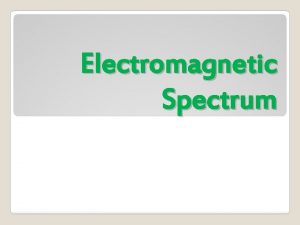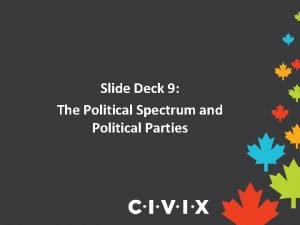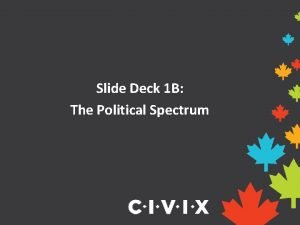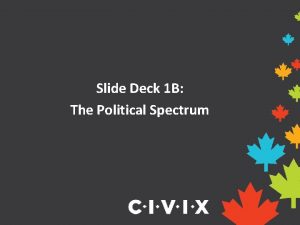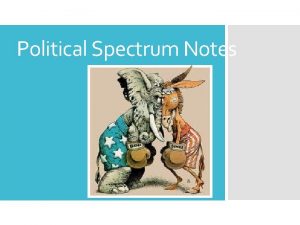POLITICAL SPECTRUM An Introduction DEFINITION A political spectrum




















- Slides: 20

POLITICAL SPECTRUM An Introduction

DEFINITION • A political spectrum is a tool used to visually compare different political positions by placing the positions on one or more axes.

• In the United States, the most commonly used political spectrum, (also known as the political continuum), places a range of beliefs along a horizontal line and is described in terms left or right of center. LEFT CENTER RIGHT

• Most commonly, the Political Spectrum tells us two things: –How much change in government a person is willing to allow (and how fast that change should take place) –How much the government should intervene, or get involved, in the lives of people (particularly with respect to the economy)

GENERAL ASSUMPTIONS LEFT More government intervention Gradual to rapid change in government RIGHT Less government intervention Little to no change in status quo

QUICK RECAP: LEFT RIGHT used to describe refers to people who hold support change traditional values in society and want less government intervention

POLITICAL SPECTRUM OF IDEOLOGIES LEFT RIGHT LIBERAL RADICAL CONSERVATIVE MODERATE REACT.

RADICAL • Far left of the political spectrum • Call for wide-sweeping rapid change in the basic structure of the political, social, or economic system. • May be willing to resort to extreme methods to bring about change, including the use of violence and revolution.

LIBERAL • Government should be actively involved in the promotion of social welfare of a nation’s citizens. • Call for peaceful, gradual change within the existing political system. • Reject violent revolution as a way of changing the way things are

MODERATE • May share viewpoints with both liberals and conservatives • Tolerant of other people’s views • Do not hold extreme views • Advocate a “go-slow” or “wait-andsee” approach to social or political change

CONSERVATIVE • Favor keeping things the way they are, or maintaining the status quo • Usually hesitant or cautious about adopting new policies, especially if they involve government activism. • They feel that the less government there is, the better.

REACTIONARY • Far right of ideological spectrum • Want to go back to the way things were—the “good ol’ days” • Often willing to use extreme methods, such as repressive use of government power, to achieve their goals

SPECTRUMS AND PARTIES • Political parties are loosely formed around these broad political ideologies.

TWO MAJOR U. S. PARTIES DEMOCRATS generally seen as liberal because they support government regulation of the economy REPUBLICANS generally seen as conservative because they advocate a reduction in government

MORE SPECIFICALLY… • Within parties, there are people who hold a variety of opinions on social and economic issues that fall along the spectrum of political ideologies • Examples are liberal Democrats, moderate Republicans, and conservative Republicans

BOTH PARTIES LEAN TOWARD MODERATE Current theorists say that U. S. political parties are becoming increasingly moderate and therefore less easily S separated on the political spectrum D N EM A C I OC RA TS L B E R U P

WHERE WOULD YOU PUT… • Communists? • Fascists? • Socialists? • Absolutists? E V I LEFT RIGHT T T A T L S V S I I A R C L E R S A I S E A C N B F I O O L S C CO MM AB RA CENTRISTS REA DIC SO UN C T. AL IST

CURRENT ISSUES LEFT • • Pro Gun Control Pro-Choice (Abortion) No Censorship Prisons should Rehabilitate • Pro-Privacy • Equal Funding for Education • Democratic Party Platform RIGHT • • Anti-Gun Control Pro-Life (Abortion) Anti-Flag Burning Prisons Should Punish • Prayer in Schools • School Vouchers • Republican Party Platform

SURVEY RESULTS • Reflect on your results! • Where did you fall? • Was this accurate? RADICAL MODERATE 500 400 LIBERAL 300 REACTIONARY 200 100 LIBERAL CONSERVATIVE LIBERAL

100% LIBERAL b Re an ag p m sh Bu le Do Ke ald Ro n Bo ck Ja e ll we Po rg Ge o n n to Cl in Co li Bi ll n on int Cl dy so ck ne Ja Ke n ry Hi lla Te d e ss Je MATCH WHERE YOU FALL WITH THE FOLLOWING POLITICAL FIGURES 100% CONSERVATIVE
 Definition of political spectrum
Definition of political spectrum Political spectrum definition
Political spectrum definition Atomic size defination
Atomic size defination Absorption spectrum vs emission spectrum
Absorption spectrum vs emission spectrum Example of political spectrum
Example of political spectrum Nationalism and political revolutions lesson 2
Nationalism and political revolutions lesson 2 Linear political spectrum
Linear political spectrum Storming of the bastille cartoon
Storming of the bastille cartoon Political vocabulary
Political vocabulary American political spectrum
American political spectrum Political spectrum line
Political spectrum line Tracking polls def
Tracking polls def Thomas hobbes political spectrum
Thomas hobbes political spectrum Politcal spectrum
Politcal spectrum Us political spectrum
Us political spectrum Political.spectrum
Political.spectrum Political spectrum canada
Political spectrum canada Political scale
Political scale Moderate in politics
Moderate in politics Standing waves ch 12:1
Standing waves ch 12:1 Em spectrum frequency
Em spectrum frequency

